 Loading... Please wait...
Loading... Please wait...Categories
- Home
- Lab Supplies
- Crystal Mounts
- MicroRT Capillaries
MicroRT Capillary
MiTeGen’s patented MicroRT™ capillary system is the answer for room temperature diffraction screening and data collection. Go from a crystal in a drop to a crystal in the X-ray beam at room temperature in 2 minutes with 99% chance of success. Collect room and low temperature data from the same crystal to evaluate your crystal and cryopreservation protocol. And use saturated salt solutions to controllably dehyrdate crystals and improve their order.
Each bottle contains 20 - 1.5" (37 mm) long clear polyester capillaries sealed at one end, an extra-keen razor blade for cutting the tubes to a desired length, and a tiny tube of grease for lubricating the base.
Why collect diffraction data at room temperature?
Room temperature screening is especially important in protein crystallography. Roughly 98% of low-temperature data sets collected on structural biology beam lines do not yield diffraction data of sufficient quality to determine a structure. Room temperature measurements are essential to determine whether the cause of poor diffraction is poor as-grown crystal quality, sample damage caused by ligand and/or cryoprotectant soaks, and/or sample damage caused by the flash cooling process itself. Far too much effort is wasted searching for cryoprotection conditions for crystals that are poorly ordered to start with. Far too much synchrotron beam time is wasted on crystals that should have been rejected in home source screening.
The MicroRT system provides an extremely cost effective tool for increasing the efficiency of your diffraction pipeline.
Design
In the MicroRT system, a sample is mounted on, e.g., a MicroMount or MicroGripper that is inserted into a goniometer base, just as for cryocrystallography. A MicroRT capillary is then drawn over the sample and onto the base.
Standard 10 μm wall glass X-ray capillaries are replaced with 25 μm wall transparent polymer capillaries that are presealed at one end. Although the polymer is thicker, it’s C and H scatter X-rays much more weakly than glass’s Si and O, so overall background scatter is reduced by 60%. The capillary diameter, 2 mm, is much larger than your crystal and MicroMount, and mates with our modified goniometer bases that both hold the MicroMount and capture the tubing.



Unlike with conventional X-ray capillary mounting, the MicroRT capillary simply provides a protective cover, and the sample makes no contact with it.
Features
- Allows rapid screening of crystals at room temperature, to help maximize the efficiency of your crystallography pipeline.
- Easy sample mounting with little risk of crystal loss or damage.
- Easy collection of both room and low-temperature data from the same sample.
- Easy sample visualization and alignment, especially for small crystals.
- Capillary tubing is easily cut and sealed , and gives significantly less background X-ray scatter than glass capillaries.
- One size capillary fits all , and capillaries are reusable, lowering your cost per measurement.
Technical
| Length | 1.5" (37 mm) (Compatible with 11-25 mm pin lengths.) |
|
| Diameter | 0.080" +/- 0.004" (2 +/- 0.1 mm) | |
| Wall Thickness | 0.001" (25 μm) | |
| Material | poly(ethylene terephthalate) | |
| Porosity | Water evaporation rate through wall at 22 °C: roughly 80 micrograms/hour. | |
| Notes | Heat sealed at one end. Optically clear. Some small optical distortion due to small wall thickness variations around the circumference. |
Celebrity Endorsements
Shultis, D. D. et. al. Crystallization and preliminary X-ray crystallographic analysis of the Escherichia coli outer membrane cobalamin transporter BtuB in complex with the carboxy-terminal domain of TonB. Acta Cryst. (2006). F62, 638-641.
Langa, P. et. al. Synthesis, capillary crystallization and preliminary joint X-ray and neutron crystallographic study of Z-DNA without polyamine at low pH. Acta Cryst. (2006). F62, 453-456.

